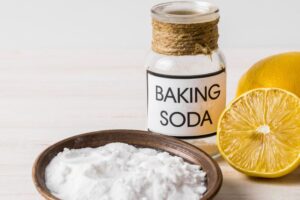Have you ever wondered why beef in Chinese cuisine is so tender and juicy? This is because most Chinese restaurants velvet the beef.

Chinese cuisines are popular for velveting beef, a technique used to tenderize meat. This keeps the meat juicy and full of flavor when cooked.
There are several ways to velvet your beef but cornstarch and baking soda are the two most typical options. Both cornstarch and baking soda can be used in this process, but they work in different ways.
Let’s consider how they are used and the best one to use to velvet your beef.
Cornstarch vs Baking Soda or Sodium Bicarbonate
Proteins like beef or chicken are velveted before they are stir-fried in Chinese food. But first, what exactly is velveting?
Velveting involves marinating meat, typically chicken, beef, or pork, in a mixture of egg white, and cornstarch. Sometimes, ingredients like rice wine or vinegar are added.
This process helps to tenderize the meat and as the name implies, create a velvety texture before it is cooked.
Velveting may be done in a variety of methods. However, the simplest way is to marinate meat in at least one alkaline ingredient.
Let’s compare the two most popular methods of velveting beef: the cornstarch and baking soda method.
Its Uses
Cornstarch is a pantry staple for Chinese cooking. It works wonders for thickening soups, stews, and sauces but it is also the main component of the slurry used to coat the meat.
Using cornstarch helps the meat simmer with more moisture retained. It also gives it a smoother texture. Cornstarch is used primarily as a coating agent.
It forms a protective layer around the meat, sealing in moisture and preventing the meat proteins from overcooking.
Baking soda is an ingredient with multipurpose uses. Many people use it especially to tenderize meat since it dissolves its fibers. When you add baking soda to your beef, it alters the pH level of the meat, making it more alkaline.

This change can help to break down proteins and tenderize the beef. However, when using baking soda for velvet beef, it is advised to exercise caution.
If not used with discretion, especially if this is your first time, it might not give you a nice flavor. To use this baking soda method, you’ll need to mix some soda with water.
The beef chunks are either refrigerated for 30 to 35 minutes, or they are soaked for approximately 30 minutes.
The Process and Recipe
The process of using the cornstarch and baking soda to velvet your meat is quite different. To use the cornstarch, The beef slices are typically coated in a mixture of cornstarch.
Sometimes you can include other ingredients like soy sauce, egg white, and rice wine. This coating is usually left on the meat for a short period before cooking. To velvet beef with cornstarch, you’ll need:
- 1 pound (450g) of thinly sliced beef (such as sirloin, flank, or tenderloin)
- 2 tablespoons cornstarch
- 1 tablespoon soy sauce
- 1 tablespoon rice wine or dry sherry
- 1 teaspoon sesame oil
- 1/4 teaspoon ground black pepper
- 1-2 tablespoons vegetable oil for stir-frying
Stir the cornstarch thoroughly until it dissolves and ensure no noticeable lumps remain before combining it with other ingredients. Some chefs recommend preparing the slurry separately and then adding it to the meat.
First, mix all the marinade ingredients very well before adding in your meat. This will ensure that all the ingredients are evenly coated on the beef. Also, it ensures that the pH [level] of the mixture is uniform throughout.
For the recipe, slice the beef thinly into bite-sized pieces. This helps in creating more tender meat. In a mixing bowl, combine cornstarch, soy sauce, rice wine or sherry, sesame oil, and black pepper.
Toss the beef thoroughly to ensure each piece is coated evenly with the mixture. Allow the beef to marinate for about 15-20 minutes at room temperature.
Then, you can proceed to stir-fry the beef in a wok or skillet over high heat. Add 1-2 tablespoons of vegetable oil and swirl it around to coat the pan evenly.
Once the pan is hot, add the marinated beef slices in a single layer. Ensure they’re not overcrowding the pan. Allow the beef to sear without stirring for about 1-2 minutes to develop a nice crust.
Stir-fry the beef continuously for another 2-3 minutes or until it’s cooked through and the cornstarch coating has turned into a glossy, velvety texture. Be careful not to overcook, as the beef can become tough.
Velveting beef with the baking soda method might be a little bit trickier. For the baking soda, the beef slices are typically marinated in a mixture containing a small amount of baking soda.
You can also include other ingredients like soy sauce, oil, and sometimes cornstarch.
The meat is left to marinate for a relatively short period before being rinsed thoroughly to remove the baking soda before cooking. For this recipe, you’ll need:
- 1 tablespoon baking soda (sodium bicarbonate)
- 1-2 tablespoons water
- 1-2 tablespoons vegetable oil (for stir-frying)
- Marinade but this is optional. You could use soy sauce, rice wine, sesame oil, and cornstarch for flavoring and to add texture.
Once you’ve prepared your beef, mix the baking soda with water. Your goal is to make the mixture paste-like. Use approximately 1 tablespoon of baking soda per pound of beef and adjust the amount of water as needed.
Then, add the sliced beef to the baking soda mixture and ensure that all pieces are thoroughly coated. Let the beef sit in this mixture for about 15-20 minutes.
Be careful not to go beyond this time frame, as the baking soda can over-tenderize the meat. After the marinating time, rinse the beef slices thoroughly under cold water to remove the baking soda.
Make sure to wash off all the baking soda. Then pat the beef dry with paper towels.
The Result

What the cornstarch does is that it creates a protective barrier on the beef. This results in a slightly crispy and well-textured surface on the beef when cooked. It doesn’t significantly alter the taste of the meat.
Also, baking soda can significantly tenderize the beef, making it more soft and tender. However, if not rinsed properly, it can impart a slightly soapy or metallic taste to the meat.
Cornstarch vs. Baking Soda: The Best Method
We’ve established that both methods can be effective in tenderizing beef for stir-frying. However, when using baking soda, make sure you’re using it sparingly and with caution.
This is basically because it is very likely to alter the taste of your dish if it is not rinsed off properly. On the other hand, using cornstarch can create a protective coating on the beef and it also gives it a desirable texture.
Whichever one you choose between cornstarch and baking soda is fine, but it completely depends on what you have in your pantry. It also depends on the texture and flavor you’re aiming for in your final dish.
Some recipes might even call for both techniques as a combination to achieve the desired results. It’s essential to follow specific recipe instructions.
This would ensure that you’re using the ingredients properly. More importantly, you can avoid any undesirable taste or alterations in the texture of the beef.
